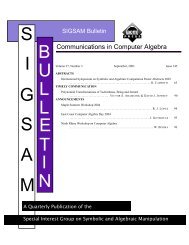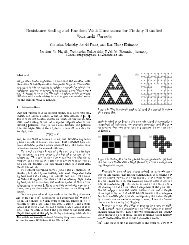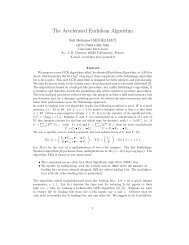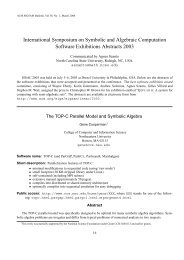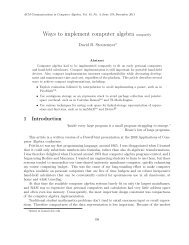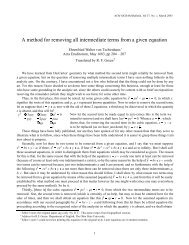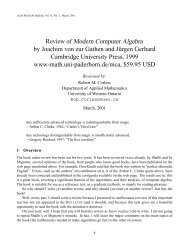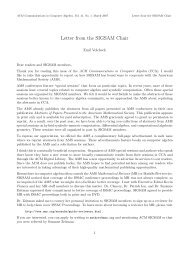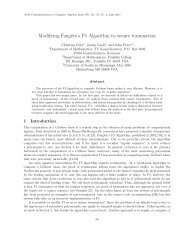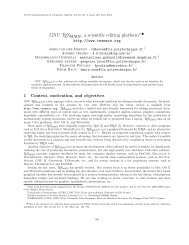Symbolic definite (and indefinite) integration: methods ... - SIGSAM
Symbolic definite (and indefinite) integration: methods ... - SIGSAM
Symbolic definite (and indefinite) integration: methods ... - SIGSAM
Create successful ePaper yourself
Turn your PDF publications into a flip-book with our unique Google optimized e-Paper software.
<strong>Symbolic</strong> <strong>integration</strong>: <strong>methods</strong> <strong>and</strong> open issues<br />
While we focus on particulars of Mathematica h<strong>and</strong>ling, I would be remiss in not pointing out<br />
that there is other work on this topic, some of which takes very different approaches to similar<br />
issues. In particular, see Davenport’s synopsis of this same topic [4], <strong>and</strong> various articles authored<br />
or coauthored by Jeffrey on removal of path singularities [7, 8, 9]. I also thank David Jeffrey <strong>and</strong><br />
an anonymous referee for numerous helpful comments <strong>and</strong> for pointing out several mistakes in an<br />
earlier draft.<br />
2 Basic Structure of Integrate Code in Mathematica<br />
2.1 In<strong>definite</strong> Integration<br />
The in<strong>definite</strong> <strong>integration</strong> code consists primarily of a partial implementation of the Risch algorithm<br />
[2, 5], in addition to extensive table lookup <strong>methods</strong>. The former h<strong>and</strong>les the elementary integral<br />
cases that do not involve algebraic extensions, <strong>and</strong> a few simple extension cases of low degree. The<br />
latter tackles integr<strong>and</strong>s with exponentials, trigonometrics <strong>and</strong>/or hyperbolics, elliptic integrals,<br />
<strong>and</strong> integr<strong>and</strong>s involving special functions, particularly after the Risch <strong>methods</strong> have given up. The<br />
actual situation is slightly more complicated in that Risch code may h<strong>and</strong>le part of an integr<strong>and</strong>,<br />
sending the rest to table lookup code. That in turn may do transformations <strong>and</strong> call back the<br />
integrate code recursively. The Mathematica implementation resorts to the Risch code early on,<br />
followed by extensive table code for h<strong>and</strong>ling of special functions as well as elementary function<br />
integr<strong>and</strong>s that this implementation of Risch fails to integrate.<br />
In addition to what is stated above, some integr<strong>and</strong> transformations are attempted prior to all<br />
else. The idea here is to recognize cases where one integr<strong>and</strong> may be converted to something that<br />
is easier to work with, but equivalent modulo a multiplicative constant (for example, transforming<br />
√<br />
x2 to x<br />
( √x<br />
2<br />
x<br />
)<br />
, <strong>and</strong> treating the second factor as a differential constant).<br />
Also useful are mathematically equivalent transformations such as factorization <strong>and</strong> partial<br />
fractions decomposition. An added wrinkle is that such transformations can invert one another,<br />
<strong>and</strong> it is often difficult to recognize which one will be beneficial to a given integr<strong>and</strong>. Thus one<br />
must take care to avoid attempting them blindly, <strong>and</strong>, in so doing, incurring the infinite wrath of<br />
the gods of recursion. In the Mathematica code base an attempt is made to determine, in various<br />
places, whether a transformation of the above type might be useful, <strong>and</strong> to apply it if so. It should<br />
be emphasized that this is, at best, a heuristic process (<strong>and</strong> at worse, a VERY recursive one...)<br />
Last we mention that there is no intrinsic reason to split into integr<strong>and</strong>s h<strong>and</strong>led by Risch vs.<br />
those that are not. Another approach might be to use table lookup (e.g. via pattern matching) as<br />
a first step, followed by a Risch implementation, followed by further lookup. In order for this to be<br />
useful the first lookup would need to be fast (that is, would need to fail quickly when it will fail at<br />
all). A table-based approach that might be useful for this first step is described [10, 12].<br />
2.2 Definite Integration<br />
Definite <strong>integration</strong> is done via a number of <strong>methods</strong> as indicated below.<br />
Special case contour <strong>integration</strong>.<br />
Newton-Leibniz code (in brief: compute an in<strong>definite</strong> integral, then evaluate it at endpoints<br />
<strong>and</strong> perhaps in limits at path singularities). There are various places where Mathematica will use<br />
this approach. The first such is specialized for integr<strong>and</strong>s of the form rational × trig or rational ×<br />
exponential.<br />
2



